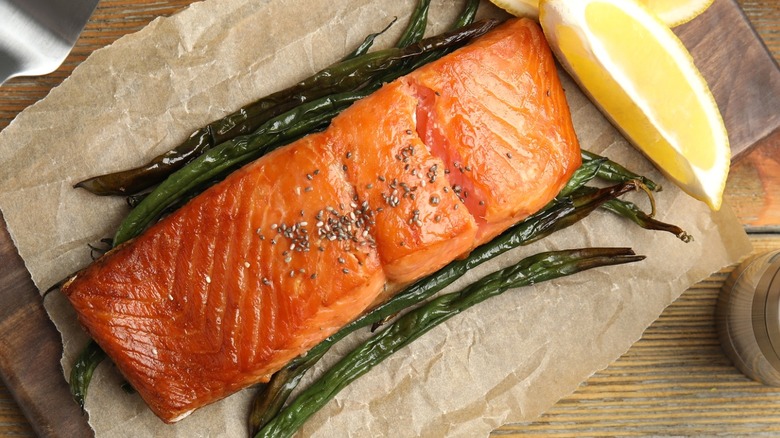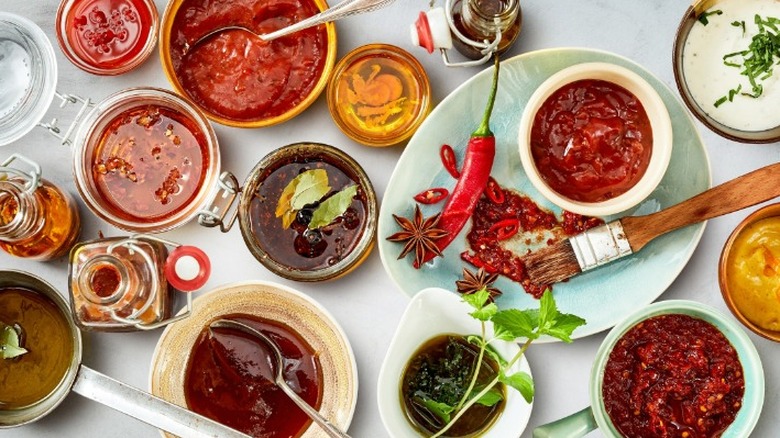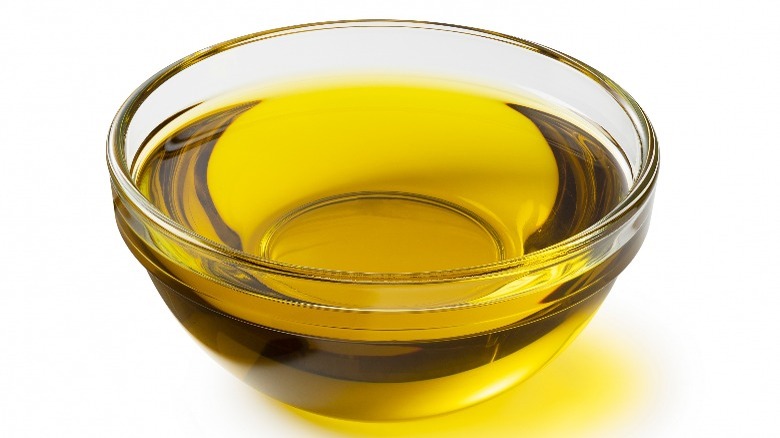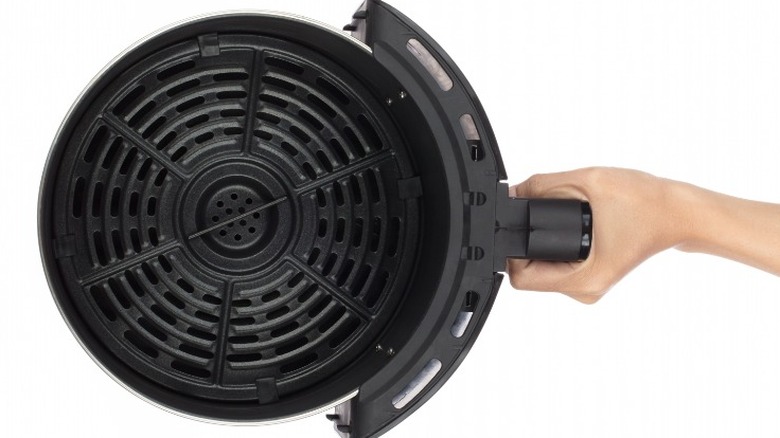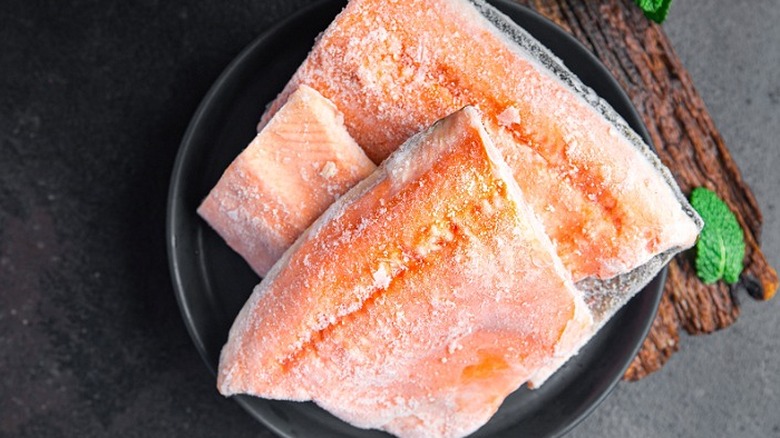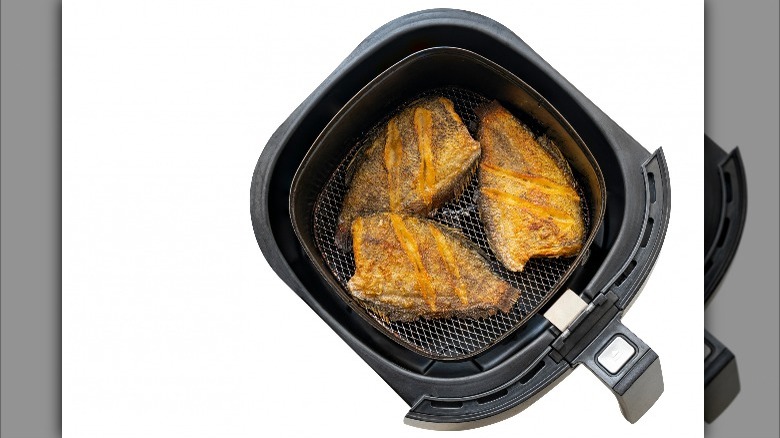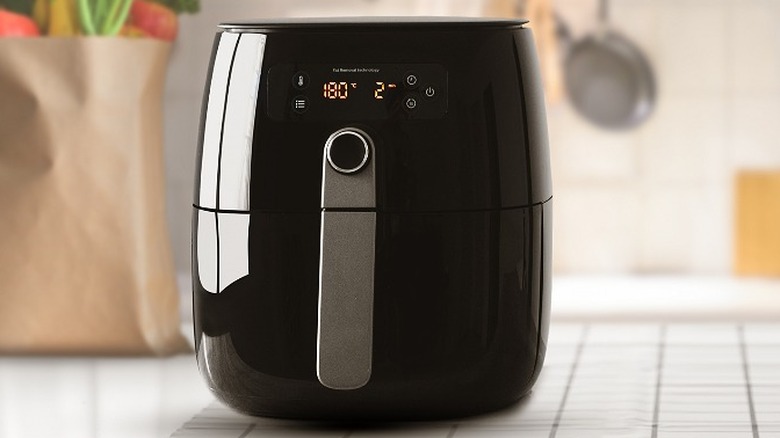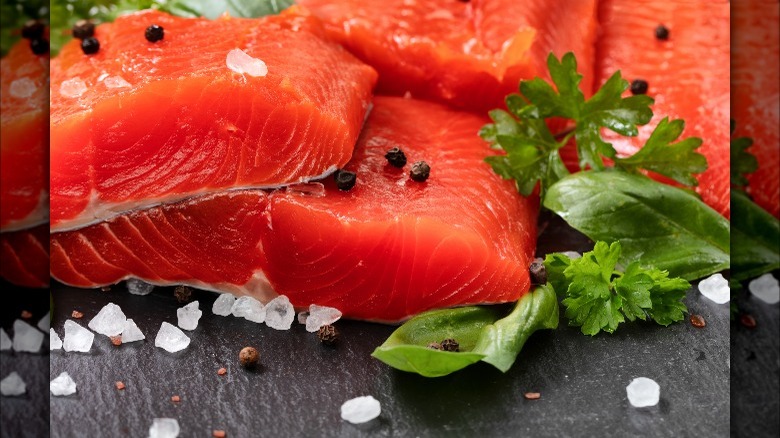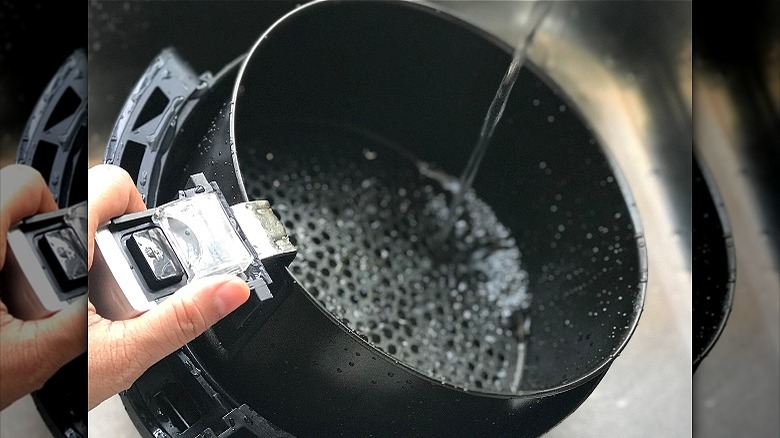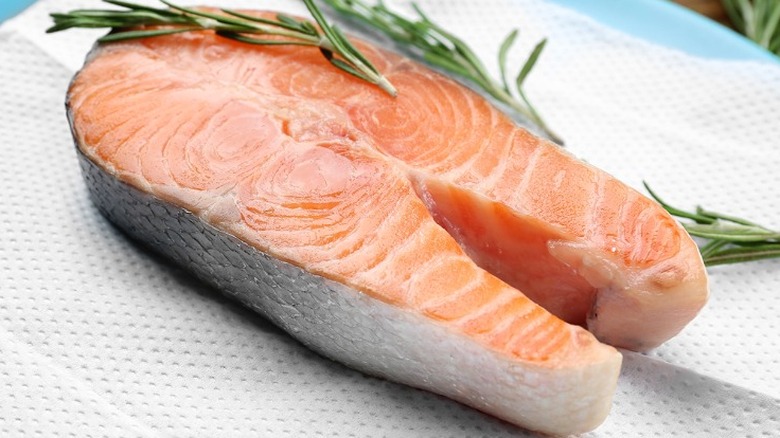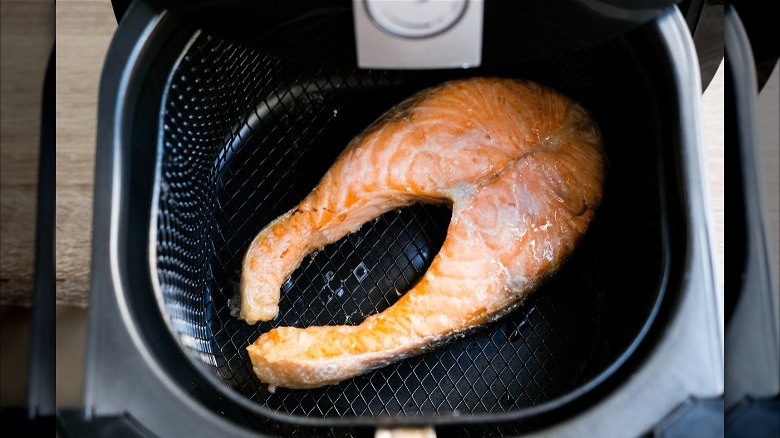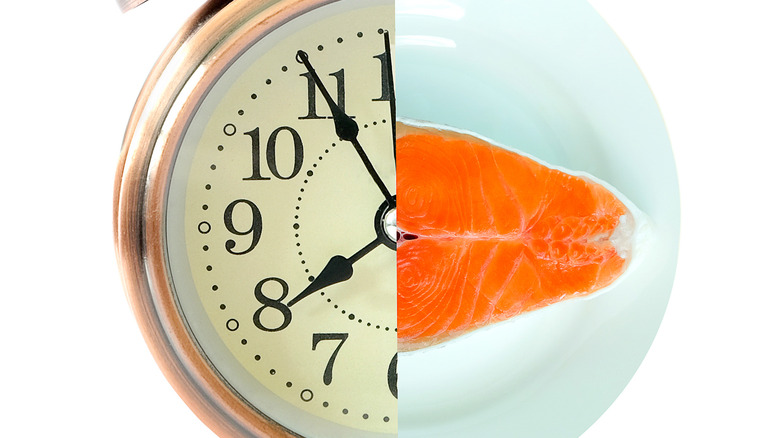Mistakes Everyone Makes When Cooking Fish In An Air Fryer
If you're a card-carrying member of the air fryer fan club, it might have already replaced many of your other kitchen devices. After all, who needs a microwave when you can defrost and heat leftovers in an air fryer? Moreover, the mess of deep frying becomes nothing more than a distant memory when air frying provides much of that same golden brown crunch you expect.
From its typically compact size to its ease of use, the air fryer is one kitchen gadget that is totally worth the hype. When it comes to throwing together a quick dinner, while you can stuff yourself silly with wings and mozzarella sticks, air fryers can cook lighter proteins like fish to moist perfection. Fish is a protein that trips up many home chefs, but air fryers take out the guesswork. Overcooking for a matter of seconds can turn the texture of your fish from heavenly to tough, and getting crispy skin seems all too elusive. Thankfully, relying on your air fryer for perfectly cooked fish can result in a meal that's delicious enough to impress guests.
Air frying makes for a quick and healthy weeknight dinner or a dazzling dinner party entree... as long as it's done right! Instead of dining on dried-out, rubbery fish, maximize the benefits of your air fryer fish by avoiding these mistakes everyone makes when cooking fish in an air fryer.
You're not using any oil or marinade on your fish
While cooking fish with any other method, using a marinade seems to come down to preference. While the same does apply to using the air fryer, you do want to ensure there's some level of moisture on your air fryer fish. Rock-hard fish is hardly appetizing, so using a marinade or oil can be your best friend. Moderation is key here, so there's no need to douse your fish to the point that it's drenched. However, there should be a level of moisture that can protect your fish from drying out.
This is particularly true if you're using skinless fish filets. The marinade acts as a barrier to keep moisture in, much like the skin would, according to AirFryer Bro. If you want to keep the flavor of your fish pure, you can always opt for a few spritzes of oil instead of a marinade. This will ensure you get all the moisture while retaining the flavor you want. But if you want to go all out and add some of your favorite flavors, you can mix garlic and dry spices with oil to create a quick marinade that will enhance your fish.
You're using too much oil on your fish
When it comes to traditional frying, having enough oil is key, so it's easy to think that this translates to air frying as well. But actually, the opposite is true.
Everyday Family Cooking suggests sticking to the golden rule of using no more than a tablespoon of oil when air frying. And if you have a spray bottle, this becomes even easier, as you can just apply a few spritzes and adjust as you see fit. A basting brush also works well here, because it gives you the control to apply only as much as you see fit — it's hard to overdo it with one of those.
Using too much oil in your air fryer may cause it to drip down onto the hot tray and burn, causing a nasty smell. It might also result in overly greasy food, which is far from appetizing. If you're working with skin-on fish, you might notice that the skin gets nice and crispy and your fish gets less dry. This is because the skin acts as a moisture-retaining barrier (via AirFryer Bro). So if you're going skinless, oil is going to make or break your fish. A little bit of oil helps your food to stay moist so it doesn't dry out, which makes it all the more enjoyable when it's time to dig in.
You're using the wrong kind of oil
If you're already an experienced air fryer user, you know there's nothing as important as oil. And while vegetable oil dominates for traditional frying, When it comes to your air fryer though, you have a bit more flexibility with oil... and it all comes down to the smoke point. While the air fryer has many merits, including its nearly foolproof functionality, you can make some decisions that will impact your final product. Because the air fryer circulates hot air, oil isn't a necessity to the cooking process, but it does help to crisp up your fish and get the same beautiful golden crust you might get with traditional frying.
Avocado oil, with its smoke point of 450 degrees Fahrenheit, is a great option for air frying your fish, explains Big Time Kitchen. Instead of smoking too quickly, it'll give your fish the moisture it needs. Olive oil, for example, has a low smoke point and may begin to impart some unsavory smoky notes before your food is finished cooking. Walnut, grapeseed, peanut, and vegetable oil are all safe bets for getting perfectly cooked fish in your air fryer. By using the correct oil for your air fryer, you can avoid the smell of smoke.
You're not greasing your air fryer basket or using a liner
There seem to be two schools of thought on whether to use a parchment paper liner in your air fryer. Some air fryer fanatics can't live without it, while others would rather leave it off and let the air circulate more freely. You might also find that by serving as a layer between your fish and the hot air fryer tray, the paper may help to prevent your fish from burning (per AirFrying.net).
When cooking something like fish, you may have marinade or oil drippings, which means that a liner will protect you from too much burning on the bottom tray. Just make sure to use properly fitted liners or cut your parchment paper to the exact size, so your paper doesn't get too close to the heating mechanism at the top. It's a quick way to circulate a burnt paper smell throughout your home. Salmon (which Metro classifies as fattier fish, among other types of fish) is an exception. Because it has a lot of its own oils that it expels while cooking, it may provide enough moisture for you to be able to skip the parchment paper.
If you also just want to prevent your fish from sticking to the tray but would rather skip the liner, you can still make sure your food is properly oiled. This will provide a layer and help to prevent your fish from adhering to the tray. With a spatula, it should be a breeze to remove.
You're not fully thawing your fish
Thawing food before throwing it into the air fryer seems to be a contentious topic. Some foods like wings can be thrown into the air fryer for an easy weeknight meal that's ready in a matter of minutes. When it comes to fish, though, the answer isn't so straightforward. It depends on the type of fish you're cooking. If you scored some frozen pre-breaded fish filets from your grocery store's freezer section, you can add them to the air fryer while frozen.
For filets that you plan to bread, you may be better off thawing them beforehand. Air Fryer Eats suggests thawing your fish before breading them so the breadcrumb can stick. And for unbreaded fish, you might find that adding it to the air fryer while frozen can generate too much water during the cooking process, making your fish bland and oddly textured (per City Fish Market). The choice is yours but if you want perfectly moist and flaky fish, we suggest letting your fish thaw before air frying (or better yet, use a lower temperature like 80 or 90 degrees for 10 minutes to defrost).
You're overcrowding your fish in the air fryer
We've all been there before. After you've loaded your air fryer basket up with your food and patiently let the food cook in the basket, you take it out only to discover it's mushy and unevenly cooked.
Although an air fryer is a miracle machine for many, because it circulates hot air around the basket as your food cooks, there's no replacement for adequate space between your food (via Air Fryer Eats). This allows the air to evenly hit all the hidden spots and provides you with an even, golden-brown cook.
With fish, the same applies, whether you're working with breaded or unbreaded pieces. As The Food Network puts it, stacking food results in underwhelming results. So instead of loading the fish into your air fryer basket like sardines in a can, try to allow each piece to have space on all sides. You'll never want to overcrowd your basket ever again.
You're not preheating your air fryer
The convenience of the air fryer can make it feel much like a microwave. It defrosts fully frozen food to cooked perfection. It can prepare dinner in minutes, while you're tackling other tasks. And it even effortlessly bakes a batch of cookies. So it's easy to forget that there's a key difference between popping food in your microwave and your air fryer.
Much like an oven, if you don't preheat your air fryer, it can result in undercooked or unevenly cooked food. This is especially true if you're trying a new type of preparation of fish and relying on precise cook times. But Air Fryer World recommends preheating frozen foods that are already cooked. For larger pieces of fish, preheating is not recommended because the air fryer will be hot enough to start cooking the outside of your fish too quickly.
If you'd like to buck convention and get your food in the air fryer basket without preheating, just remember that you may need to add an extra minute or two to the cooking time to ensure your fish is perfectly cooked. This is one of those judgment calls that depends on what you're cooking and how you want it prepared, but overall, preheating is one more way to ensure your food is cooked exactly as you want it.
You're not seasoning your fish before you put it in the air fryer
Call us curmudgeonly, but some cooking hacks seem to make seasoning seem like a second thought. This is something that's hard to debate, especially when you consider that seasoning is as simple as a dash of salt and pepper. There's not much to it. Just pat your fish dry and then add a sprinkle of the seasonings of your choice before popping it into the air fryer, according to Professional Secrets. And we even suggest a dash for pre-cooked breaded fish filets as well.
Salting your fish before cooking is the key to a well-flavored, balanced dish. The salt will soak into the fish and enhance the flavor as it cooks, but when you salt a dish after it's cooked, the salt doesn't absorb in quite the same way. We know the air fryer works magic, but some things you'll have to take into your own hands.
You're not cleaning your air fryer before adding fish
If you've ever noticed that your dish had the faint taste of something else, it might be the lingering oils of your previously-cooked food. This should go without saying... but clean your air fryer. Wipe it down. Depending on the material of your basket, you may not want to submerge it in water, but if you take a wet towel and wipe the entire inside of the machine down thoroughly, you'll be happy you did. It's easy to neglect your air fryer because it works so well without much maintenance, but cleaning it will help retain the pure flavors of your food. Your food might taste odd because of a filter issue, explains Ask Air Fryer, but you're probably going to see results with just a simple cleaning.
You should also clean your air fryer after each use, especially when cooking fish. It's the quickest way to ensure the next dish you cook doesn't take on any fishy qualities. And it also helps prevent the circulating of those fish smells.
You're not patting your fish enough
In some cases, a wet batter is key to locking in flavor and getting a thick crust on your fried fish. But with any kind of frying, including using an air fryer, patting your fish dry with a paper towel first can ensure that your filets get nice and brown, according to City Fish Market.
Ensuring your fish is dry before seasoning and cooking it will help your fish to prevent your fish from taking on a mushy texture. The goal is firm, flaky fish, and it's rather simple to get these results in the air fryer thanks to how hot the air gets and how fast it circulates around your fish. And when you remove some of that moisture, it allows the fish to achieve that dreamy, melt-in-your-mouth texture. Patting your fish dry won't solve all your problems, but it will make your air fryer fish way more enjoyable.
You're not flipping your fish
With other methods of cooking fish, (except roasting) flipping halfway during the cooking time is expected. But because air fryers circulate hot air, it's often assumed that flipping your fish is optional. We'd like to put this idea to rest. Even if you're pretty happy with your air-fried fish, we suggest flipping your fish to get a more even cook.
America's Test Kitchen explains that because air fryer baskets are so small, the air that's circulating doesn't have much room to move around. So it's in motion, but it doesn't have many places to go. By giving your fish a flip, you'll expose the bottom side to the same heat that the top side received, especially since the fans are usually at the top of the machine. So while we like to think of air fryers as a fantastic set-it-and-forget-it option, keeping your eye on your device and flipping your fish halfway will help you to get perfectly-cooked fish every time. This is especially important if you're hoping to achieve the elusive crispy skin. It's more than possible in the air fryer. Just flip your halfway, ensuring the fish is skin-side-up during the second half of the cooking process.
You're overcooking your fish
Overcooking fish is a risk when using any kind of cooking method. Because the protein breaks down faster and with less temperature needed for beef or chicken, explains Exploratorium, it's easy to go from perfectly cooked to rubbery in a matter of minutes. And in the air fryer, which uses a fan to circulate hot air, overcooked fish is all too common.
When fish is raw, it's got an undeniable translucent quality. If you keep your eye on your air-fried fish and take it out as soon as it's no longer translucent and has reached an internal temperature of 145 degrees (as suggested by Better Homes & Gardens), you should be pretty happy with the final product. Because every air fryer operates slightly differently, there's no set of one-size-fits-all instructions for getting perfectly cooked fish. But starting with a temperature of 390 to 400 degrees Fahrenheit for around 10 minutes, according to AirFrying.net, should point you in the right direction. As soon as it's no longer see-through and it flakes apart with your fork, you should be all set to dig into moist, perfectly cooked fish.
